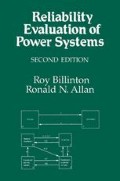Abstract
As discussed in Section 2.1, the time span for a power system is divided into two sectors: the planning phase, which was the subject of Chapters 2–4, and the operating phase. In power system operation, the expected load must be predicted (short-term load forecasting) and sufficient generation must be scheduled accordingly. Reserve generation must also be scheduled in order to account for load forecast uncertainties and possible outages of generation plant. Once this capacity is scheduled and spinning, the operator is committed for the period of time it takes to achieve output from other generating plant; this time may be several hours in the case of thermal units but only a few minutes in the case of gas turbines and hydroelectric plant.
Access this chapter
Tax calculation will be finalised at checkout
Purchases are for personal use only
Preview
Unable to display preview. Download preview PDF.
References
IEEE Committee Report, ‘Bibliography on the application of probability methods in power system reliability evaluation’, IEEE Trans. on Power Apparatus and Systems, PAS-91 (1972), pp. 649–60.
IEEE Committee Report, ‘Bibliography on the application of probability methods in power system reliability evaluation 1971–1977’, IEEE Trans. on Power Apparatus and Systems, PAS-97 (1978), pp. 2235–42.
Anstine, L. T., Burke, R. E., Casey, J. E., Holgate, R., John, R. S., Stewart, H. G., ‘Application of probability methods to the determination of spinning reserve requirements for the Pennsylvania—New Jersey—Maryland interconnection’, IEEE Trans. on Power Apparatus and Systems, PAS-82 (1963), pp. 720–35.
Billinton, R., Jain, A. V, ‘Unit derating levels in spinning reserve studies’, IEEE Trans. on Power Apparatus and Systems, PAS-90 (1971), pp. 1677–87.
Billinton, R., Jain, A. V, ‘The effect of rapid start and hot reserve units in spinning reserve studies’, IEEE Trans. on Power Apparatus and Systems, PAS-91 (1972), pp. 511–16.
Allan, R. N., Nunes, R. A. R, Modelling of Standby Generating Units in Short-term Reliability Evaluation, IEEE Winter Power Meeting, New York, 1979, paper A79 006–8.
IEEE Task Group on Models for Peaking Service Units, A Four State Model for Estimation of Outage Risk for Units in Peaking Service, IEEE Winter Power Meeting, New York, 1971, paper TP 90 PWR.
Billinton, R., Alam, M., Outage Postponability Effects in Operating Capacity Reliability Studies, IEEE Winter Power Meeting, New York, 1978, paper A78 064–8.
Patton, A. D., ‘A probability method for bulk power system security assessment: I—Basic concepts’, IEEE Trans. on Power Apparatus and Systems, PAS-91 (1972), pp. 54–61.
Patton, A. D., ‘A probability method for bulk power system security assessment: II—Development of probability methods for normally operating components’, IEEE Trans. on Power Apparatus and Systems, PAS-91 (1972), pp. 2480–5.
Patton, A. D., ‘A probability method for bulk power system security assessment: III—Models for standby generators and field data collection and analysis’, IEEE Trans. on Power Apparatus and Systems, PAS-91 (1972), pp. 2486–93.
Jain, A. V, Billinton, R., Spinning Reserve Allocation in a Complex Power System, IEEE Winter Power Meeting, New York, 1973, paper C73 097–3.
Billinton, R., Jain, A. V., ‘Interconnected system spinning reserve requirements’, IEEE Trans. on Power Apparatus and Systems, PAS-91 (1972), pp. 517–26.
Billinton, R., Jain, A. V., ‘Power system spinning reserve determination in a multi-system configuration’, IEEE Trans. on Power Apparatus and Systems, PAS-92 (1973), pp. 433–41.
Author information
Authors and Affiliations
Rights and permissions
Copyright information
© 1996 Springer Science+Business Media New York
About this chapter
Cite this chapter
Billinton, R., Allan, R.N. (1996). Operating reserve. In: Reliability Evaluation of Power Systems. Springer, Boston, MA. https://doi.org/10.1007/978-1-4899-1860-4_5
Download citation
DOI: https://doi.org/10.1007/978-1-4899-1860-4_5
Publisher Name: Springer, Boston, MA
Print ISBN: 978-1-4899-1862-8
Online ISBN: 978-1-4899-1860-4
eBook Packages: Springer Book Archive

